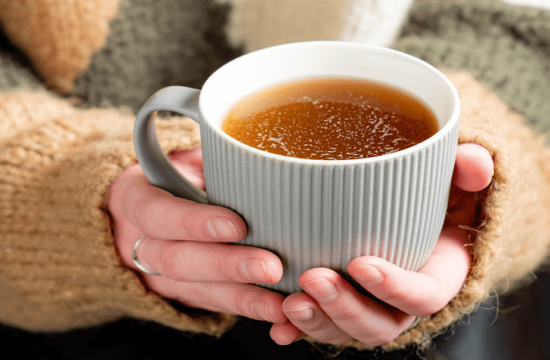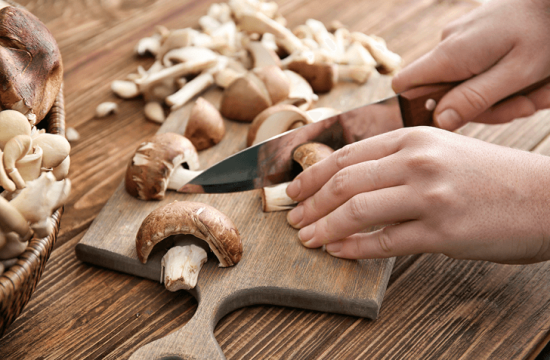This article explains Sushruta Samhita Sutrasthana Chapter 1 “Vedotpatti Adhyaya ” – Origin of the Science of Life
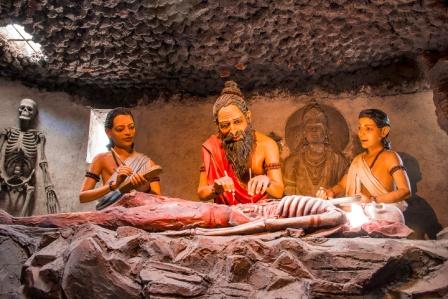

Vedotpatti Adhyaya- Origin of the Science of Life
We will now expound the chapter ”Origin of the science of Life” as revealed by the Venerable Dhanvantari.
Sages approaching Divodasa Dhanwantari
Once upon a time, having approached the venerable king of Kashi, Divodasa Dhanvantari, who is considered as the best among the immortals, who was surrounded by groups of sages and had resided in a hermitage, Aupadhenava, Vaitarana, Aurabhra, Paushkalavata, Karavirya, Gopura Rakshita, Sushruta and others appealed to him thus.
Read – Lord Dhanwantari ‘The God of Ayurveda’
Sages requesting Divodasa Dhanwantari to teach ‘Ayurveda’ to them
“Venerable sir, we are greatly pained to see the people of the world who are suffering and grieved by different kinds of pains caused by diseases of the body and mind and those caused by external causes, and those, in spite of having many well-wishers, friends, family, wealth and comforts suffer from different kinds of miseries and grieve as if they have none of these. Therefore, we desire to learn Ayurveda (the science of life) being taught by your kind self here, with the purpose of curing the diseases of those ailing and for those who are seeking happiness (in the form of freedom from their diseases), to protect and shield one’s life from the impact and attack of diseases, and for the benefit and wellness of all the people of the world. In this Ayurveda is embedded (enshrined) all the benefits and goodness of the lives of this world (present) and the other world (future). So, we have come to you as your disciples, venerable sir”.
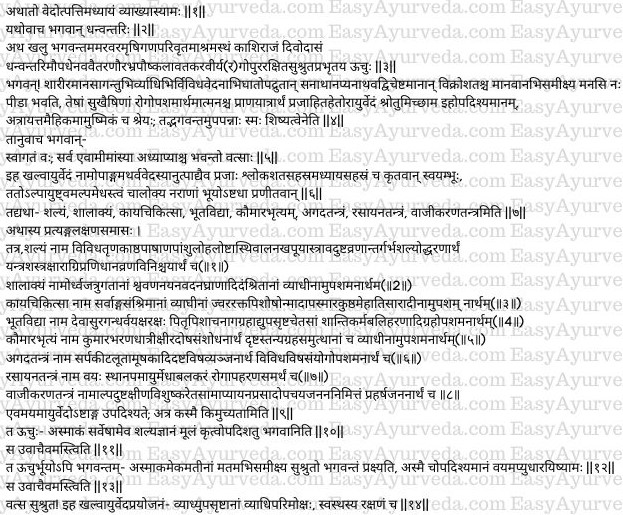

Notes: Divodasa was the personal name of the king of Kashi. He was also called as Divodasa Dhanvantari. Dhanvantari was an epithet, since Divodasa was known as the incarnation of Dhanvantari, the God Of medicine. Divodasa had lived in a hermitage. This suggests that he had freed himself from all powers and attachments, had handed over the reins of kingship to some other person and was leading the life of a saint imparting the knowledge of Ayurveda, mainly the surgical aspect of Ayurveda to others.
Read – Ayurveda Made Easy – Science of Spirituality, Health, Disease
Master Dalhana, the commentator of Susruta Samhita gives the derivation of the term ‘Dhanvantari’ as
” धनुः शाल्य शास्त्रं,तस्य अन्तं पारम् इयर्ति गन्छतीति धन्वन्तरिः”
Meaning – “Dhanu means surgical science. He who has reached the end of the science of surgery (who has learnt and practised surgery completely and comprehensively) is called as Dhanwantari”. He must have been a reputed scholar, since many students; including some disciples belonging to other countries (other than India) came to him to learn Ayurveda.
Lord Dhanwantari welcomes the disciples
Then, the Venerable one (Lord Dhanwantari) said, ”Welcome to you dear sons. You all have come with a good intention. All of you are indisputable (regarding your credentials) and are worthy to be taught”.
Ayurvedotpatti
Genesis of Ayurveda
This science Ayurveda is a branch of Atharva Veda. It comprises of eight sections. In ancient time, even before the creation of this world, the self-born (creator of the world – Lord Brahma) propounded this science named Ayurveda and composed it with one hundred thousand (1 lakh) verses and one thousand chapters (1 lakh verses spread out in 1,000 chapters). Later, Lord Brahma, having noticed that the people are of lesser life span (short lived) and of poor intelligence, he divided Ayurveda into eight branches.
Read – How Ayurveda Originated? Detailed Explanation [Video]
Branches of Ayurveda
The eight branches of Ayurveda are as below mentioned –
- Shalya Tantra – surgery
- Shalakya Tantra – ophthalmology, diseases of ear, nose and throat (oto-rhino-laryngology etc.)
- Kaya Chikitsa Tantra – internal / general medicine
- Bhuta Vidya – demonology
- Kaumarabhritya Tantra – paediatrics
- Agada Tantra – toxicology
- Rasayana Tantra – rejuvenation therapy
- Vajikarana Tantra – aphrodisiac therapy
Read – Ashtanga Ayurveda – The Eight Branches of Ayurveda
1. Shalya Tantra
Now, the features of each branch of Ayurveda shall be explained in brief.
Shalya Tantra:- is the name of that branch (of Ayurveda) which describes the methods and gives one the knowledge of removal of different kinds of foreign objects, such as grass, wood, stone, sand, metal, mud pellets, bone, hair and nail, pus, discharges (exudates), contaminated (vitiated) wound / ulcer, foreign bodies impacted deep inside the body and foetus (dead foetus) by proper use of blunt instruments, sharp instruments, caustic alkalies and fire (cautery) and diagnosis of ulcers / wounds and knowledge of different kinds (stages) of ulcers like ama (unripe), pacyamana (in the process of ripening) and pakva (ripened) vrana.
Read – Methods Of Surgical Training Elaborated In Ayurveda
2. Shalakya Tantra
Shalakya Tantra:- is the name of that branch of Ayurveda which deals with explanation of the use of shalaka yantras (tubular instruments useful in diagnosing and treating the diseases of the organs above the level of the collar bones) in treating the diseases of the parts of the body located above the level of collar bones (shoulders) which include the diseases of the ears, eyes, mouth and nose etc.
Read – Eye Diseases Causes, Pathogenesis, Symptoms, Treatment, Herbs
3. Kaya Chikitsa
Kaya Cikitsa:- is the name of that branch of Ayurveda which describes the diseases affecting all the parts of the body including jwara (fever), raktapitta (bleeding disorders), sosa (consumption, tuberculosis), unmada (insanity, psychosis, lunacy), apasmara (epilepsy), kustha (leprosy, skin disorders), meha (diabetes), atisara (diarrhoea) etc. and their treatment.
Read – Kaya: Understanding The Term In Different Ayurveda Contexts
4. Bhuta Vidya
Bhuta Vidya:- is the name of that branch of Ayurveda which describes the features of persons whose mind has been affected by (possessed by) spirits, like Deva, Asura, Gandharva, Yaksha, Rakshasa, Pitru, Pishacha, Naga etc. and various methods to pacify them including shantikarma (pacification rites), baliharana (offering oblations and sacrifices) etc.
5. Kaumara Bhrutya
Kaumara Bhrutya:- is the name of that branch of Ayurveda which describes the methods of bringing up (looking after) the children, methods of purification of breast milk of the wet nurse / mother of its impurities, diseases arising from vitiated breast milk (in the child), diseases caused by grahas (demons, supernatural entities) and their treatment.
Read – Symptoms That Hint Towards Different Diseases In Babies
6. Agada Tantra
AgadaTantra:- is the name of that branch of Ayurveda which describes the features of bites by poisonous animals like snakes, insects, spiders, rats etc., diseases caused by different kinds of poisons (natural, artificial and combination of poisons) and their treatment.
7. Rasayana Tantra
Rasayana Tantra:- is the name of that branch of Ayurveda which describes the methods of withholding aging (anti-ageing – making one retain feel of youth in spite of biological ageing, by enhancing the overall strength and endurance of the tissues of the body), increasing life-span, intelligence, strength (immunity) and capacity to get rid of diseases.
8. Vajikarana Tantra
Vajikarana Tantra:- is the name of that branch of Ayurveda which deals with methods of nourishing, cleansing, increasing and producing semen which is either less, vitiated, decreased or dried up, or bestowing sexual pleasure.
Read – Charaka Chikitsa 2.1 Samyoga Sharamuliya Vajikarana Pada
Master Dhanwantari enquires about ‘subject (section) of interest with his disciples
Lord Dhanwantari asks his disciples – “In this manner Ayurveda is described as Ashtanga i.e., that having eight branches. Among these branches, which branch should be taught to which disciple (who is interested to learn which branch of Ayurveda?)?”
Reply to the master by his students
They (students) said “Venerable sir, please teach all of us Ayurveda mainly pertaining to ‘Shalya Tantra – the surgical science’.
Replying to his student’s request, he (Master Divodasa Dhanvantari) said – ‘So be it’.
Disciples assign Sushruta as their representative to question and receive the knowledge of Ayurveda from Master Dhanvantari
They (disciples) further said (to master Dhanwantari) – “All of us think alike and share similar opinions (unanimous in our mind – like minded). Sushruta, one among us, understanding our thoughts and opinions will speak and question you on behalf of us venerable sir. And all that you reply and teach him in the form of the knowledge of Ayurveda will reach us (in the same and unadulterated form) and we shall receive the same.”
Read – Acharya Sushruta: Work, Samhita, Legacy, Amazing Facts
To this he (Divodasa Dhanvantari) said, “So be it!”
Purpose of Ayurveda
Master Divodasa said – ‘Dear son Sushruta, please listen; Susruta, dear son, listen; the two main purposes of Ayurveda are – curing the diseases of those afflicted by diseases and protecting those who are healthy”.
Nirukti
Definition of Ayurveda
“Ayurveda is that (science) in the teachings and preaching of which ‘ayu-life or knowledge of life’ (everything beneficial and non-beneficial for ayu) is present (understood) or by the teachings and preaching of which ‘ayu-life i.e., long and healthy life, longevity’ is attained”.
Master Divodasa pledges to teach Shalya Tantra to Sushruta
Tells Master Divodasa – “Now listen to me (and understand) as I teach the best and first branch of Ayurveda (i.e., Shalya Tantra or Surgery) in a way which is not contrary to pratyaksha (direct perception), agama (teaching of scriptures), anumana (inference) and upamana (analogy)”.
Shalyatantram Pradhanyam
Importance of Surgery
“This branch i.e., Shalya tantra – surgery is the first one among the eight branches of Ayurveda because long ago the accidental / traumatic wounds (which had occurred during the battle between Gods and Demons) were healed and the severed head of Yajna (Daksha) was rejoined (by methods described in this branch).
It is heard that the head of Yajna (Daksa) was cut off by an angry Lord Rudra. Then the Gods approached Aswini twins (celestial physicians – physicians to Gods) and told them; – “You, the venerable twins, are the best among the Gods, you both should re-join the severed head of Yajna. To this (appeal) the Asvini twins agreed to comply. Then the Gods requested Lord Indra to favour the Asvini twins (Asvinis) with a share (of oblations) in the sacrifices. In this way the Asvini twins re-joined the head of Yajna”.
Read – Ayurveda In Puranas And Upa Puranas: Description of References
Importance of Shalya Tantra
The master further states –
‘Out of all the eight branches of Ayurveda, this branch (surgery) alone is considered to be great. This is because of its quick action (in terms of treatment and cure / removal of disease or diseased part) and extensive use of blunt instruments, sharp instruments, alkali (for cauterization) and fire (for cauterization) and its similarity to the other branches of Ayurveda (treatment and purpose of treatment in this branch is similar to that of other branches)’.
Read – Shastra – Surgical Instruments Of Ayurveda: Astang Hriday Sutrasthana 26
Qualities of Shalya Tantra
Hence, this branch (Shalya Tantra – surgery) is
- Shashvata – eternal
- Punyam – virtuous
- Svargyam – a means to reach heaven (attain salvation?)
- Yashasya – helps in attaining reputation
- Ayushyam – helps in attaining longevity (long life)
- Vrttikaram – helps to lead a successful professional career
Propagation of Ayurveda
Lord Brahma revealed this (science of Ayurveda) first.
Next, Prajapati learnt Ayurveda from Brahma.
Later, Ashvini twins learnt Ayurveda from Prajapati.
From Ashvini twins Lord Indra learnt the science of Ayurveda.
I learnt Ayurveda from Lord Indra.
Now I am teaching it to all of you who have come to me with a desire to learn it, for doing good to the living beings (people) of the world.(This is the sequence in which Ayurveda was propagated from Lord Brahma to Divodasa Dhanwantari and from him to his disciples.)
Divodasa claims that he is Lord Dhanvantari
Here is a verse thus:-
“I myself am Dhanvantari, the adideva – the first God, who cured the immortals (Gods) from old age, disease and death; now I have once again reincarnated on this earth to teach Shalya Tantra (surgery) along with other branches of Ayurveda”.
Read – Compilation Of Treatise, Evaluation And Graduation In Ayurveda
Purusam Pradhanam
Importance of Man
In this science (Ayurveda), purusha (man, human being) is considered as the conglomeration of the Panca Bhutas (five primary elements of nature which are also involved in the creation, including human beings i.e., prithvi = earth, ap = water, tejas = fire, vayu = air and akasa = ether, space) and Sariri (atma = soul).
It is this purusa towards whom all the treatments are planned and implemented (receiver of all treatments) and it is the same purusa is the adhistana (abode) of treatment and fruits (results) of treatments implemented over him or an abode of health and diseases. This is because this world is of two kinds and all life is divided into two categories i.e., sthavara (immobile) and jangama (mobile). Or due to the predominance of fire and water elements, the world (all life) is also of two kinds – Agneya (fiery, hot) and Saumya (calm, watery, cold). The world / all life is also of five kinds being made up and composed of five elements of nature (creation).
In this world, all living beings are classified into four categories (four kinds of living beings) i.e.,
- Samsvedaja – born from sweat and such other dirt
- Jarayuja – born from the placenta / womb
- Andaja – born from egg and
- Udbhija – born from breaking the ground
Among these, Purusha (man) is the most important. All others are tools for him. Hence Purusha is the basis (subject) / abode (adhistana).
Read – Purusha: Definition, Types, Characteristic Features
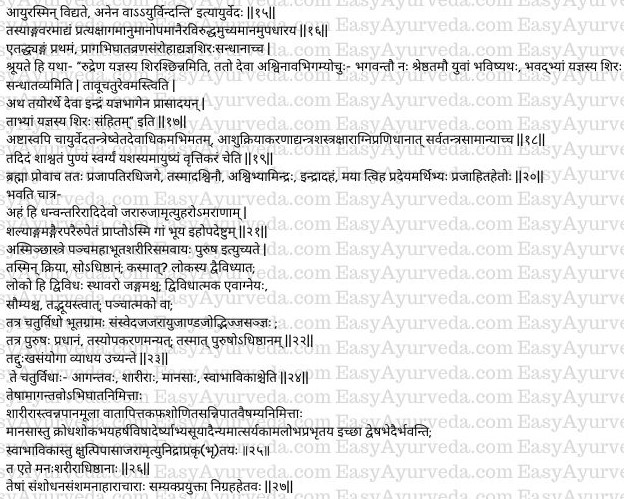

Vyadhi
Definition and types of diseases
Association of miseries or sufferings with him (man) are known as Vyadhi (diseases). (Putting it the other way, those who get associated with purusa bring miseries and sufferings in him are known as vyadhi – diseases).
The vyadhis are of four kinds, i.e.
- Agantu – those caused by external agents / causes (exogenous)
- Sharira – those which occur in the body / physical level (somatic)
- Manasa – those which occur in the mind (psychic)
- Svabhavika – natural diseases
Explanation of four kinds of vyadhi
Among these,
1. Agantu (exogenous) diseases – are those caused by assaults / injury (by weapons, sticks, stones etc).
2. Sharirika diseases – are those caused by aggravated or imbalanced vata, pitta, kapha and sonita (blood) either individually or in combinations brought about by indulgence of foods and drinks (taken in less, excess or abnormal proportions) which bring about abnormalities in these doshas.
3. Manasika diseases – are those produced by anger, grief, fear, extreme joy, sadness (depression), jealousy / intolerance, jealousy, timidity (helplessness) or weakness of mind, enviousness / hatred (jealousy), lust (desire), greed etc. and due to various kinds of likes (desire) and dislikes (hatred).
4. Swabhavika diseases – include hunger, thirst, old age, death, sleep etc. which occur naturally.
Read – Vyadhi (Disease) Definition, Meaning And Explanation
Vyadhi Adhistana
Seats of diseases
Manas (mind) and Sharira (body) are the seats of these (diseases).
(All these four kinds of diseases have their origin from mind or body or both. Therefore, the mind and body are the seats of diseases).
Vyadhi Nigraha
Control of diseases
These diseases can be controlled (prevented or cured) by proper administration of samsodana (purificatory therapies), samsamana (palliative therapies), ahara (administration of wholesome foods) and acara (administration of wholesome activities and practices).
(These methods shall be planned properly and administered in accordance to the habitat, time or season, age, dose etc.).
Read – Chikitsa: Treatment Types, Ayurvedic classification
Ahara-Aushadha
Foods and drugs
Ahara (food) is the ‘root of sustenance of life’ for all the living beings. It is also the cause for their strength, colour, complexion and vitality (protects or enhances these components). These foods comprise six tastes or are abodes of six tastes. These tastes are seated in their respective dravyas (substances). These substances are in turn the drugs (medicinal herbs) / medicines. These (medicines) are of two kinds i.e., sthavara (immobile, plant kingdom) and jangama (mobile, animal kingdom).
Notes: –
The six tastes are –
- Madhura (sweet),
- Amla (sour),
- Lavana (salt),
- Katu (pungent),
- Tikta (bitter) and
- Kashaya (astringent)
Dravya – is defined as a substance possessing properties and actions. The term dravya includes all the objects of the universe. In this chapter the word dravya has been used in a limited sense to denote drugs (medicinal substances).
Oshadhi / Aushadhi – This term is also applied in a restricted sense in this chapter. It denotes those plants which perish after their fruits get matured. Many cereals, legumes etc. which are used as food and many plants used as medicines (herbs) also belong to this category.
Read – Food – Definition, Importance As Per Ayurveda, Upanishad
Sthavara – Plant Kingdom
Among these two,
Sthavara (plant kingdom) is of four kinds i.e., Vanaspati, Vriksha, Virudha and Oshadhi.
- Vanaspati – are those which do not have flowers but bear fruits.
- Vriksia – are those which bear both flowers (first) and fruits.
- Viruddha – are those which spread on the ground or on other plants (creepers and shrubs).
- Aushadi / Oshadhi – are those which exist only until the fruits ripen (perish after their fruits ripen).
Jangama – Animal Kingdom
Even the Jangama (animal kingdom) is four kinds i.e., Jarayuja (born from placenta / womb), Andaja (born from the egg), Svedaja (born from sweat / warmth and such other dirt) and Udbhija (born from the earth).
Among these,
- Jarayuja group includes – cattle, man (human), wild animals (tiger, lion etc.)
- Andaja group includes – birds, snakes, creeping animals (snakes, lizards, crocodile, fishes) etc.
- Svedaja group includes – worms, insects, ants etc.
- Udbhija group includes – Indragopa (cochineal insect), frog etc.
Upayukta Anga
Parts useful for medical purpose
Useful parts from sthavara group – Below mentioned are the useful parts from plant kingdom –
- Tvak – bark
- Patra – leaves
- Pushpa – flowers
- Phala – fruits
- Mula – roots
- Kanda – rhizomes
- Niryasa – gum, resin
- Svarasa – latex, sap etc.
Useful parts from jangama group – Below mentioned are the useful parts from animal kingdom –
Parthiva Dravyas
Among parthiva dravyas (materials derived from / born from earth) – gold, silver, precious stones, pearls, orpiment, mud and pieces of earthen pot are useful.
Note – Ores and metals are also included under Sthavara category only.
Kala Krita- Effects of time
The special factors of kala (time factor) which are beneficial from treatment perspective are – pravata (heavy breeze), nivata (mild breeze), atapa (sunlight), chaya (shade), jyotsna (moonlight), tama (darkness), shita (cold), ushna (heat, warmth), varsha (rains), ahoratra (day and night), paksa (fortnight), masa (month), rtu (seasons), ayana (solstice) and samvatsara (year) etc.
By their basic nature themselves, these variants of time factor (mentioned above) act as causes for sancaya (accumulation, mild increase), prakopa (aggravation, severe increase), prashama (pacification of aggravated doshas to their normal state) and pratikara (cure, remedy) of doshas, and hence are useful.
Note:- The above are the various changes occurring with respect to time and climatic conditions regularly which also give rise to diseases. They are included under Kalakrta (caused due to effect of time and seasons) category since they cannot be included under either of the sthavara or jangama category.
Knowledge of each one of these is useful for understanding the diseases and adopting suitable treatment.
Read – Kala – The Time Factor
Sthavara etc. groups are causes for increase and decrease of physical diseases
Some more verses here:-
The physicians consider these four groups as the causes for increase (aggravation or exacerbation) and decrease (diminish, pacify, and subside) of the diseases of the body.
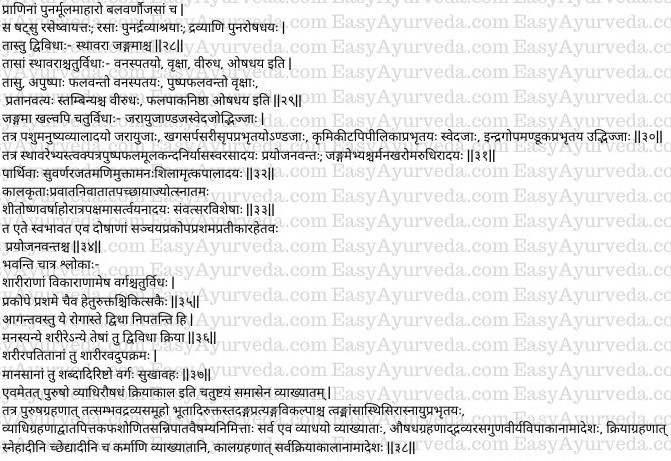

Location of Agantuja Disorders
Agantu (produced by external causes) diseases have two abodes or locations. Putting it in other words, the diseases caused by external causes are said to be of two kinds based on where they manifest – as those occurring in the body (physical level) and those occurring in the mind (mental level).
The treatments for these are also of two kinds.
- The agantu diseases manifesting in the body should be treated on similar lines of treating the diseases of the body (physical disorders).
- The agantu diseases manifesting in the mind treatment shall be done by associating the patient with sound etc. (objects of sense organs) which bring about happiness (and relief).
So far, Purusha (Man), Vyadhi (disease), Aushadha (drugs and treatment) and Kriyakala (times of activity / treatment) – these four were described in brief.
Purusha – The term ‘Purusha (Man)’ includes all the substances which are responsible for formation of purusha, such as pancha mahabhutas i.e., five primary elements of nature, the sperm and ovum which are made up of these five elements and all the major and minor organs (parts) of the body including skin, muscles, bones, veins, ligaments etc.
Vyadhi – The term vyadhi covers all the diseases produced by aggravated / imbalanced (abnormalities) of vata, pitta, kapha and sonata (blood), either individually or combination of all of them.
Aushadha – The term aushadha (medicament) includes the substance (drug, herb, medicine here), its tastes, qualities, properties, potency, effects after digestion etc.
Kriya – The term kriya (actions) includes the eight types of surgical methods like excision, incision etc., oleation, and sudation and panchakarma procedures.
Kala – The term kala includes all the periods for doing all the activities i.e., proper time for conducting treatments. (Some have also included the periods of activities of diseases and drugs in this category).
Read – Shat Kriya Kala – ‘Stage-Wise Disease Management’


Summary of the context / chapter
One more verse here:-
In this context, the seed (essence, kernel) of the entire medical science has been thus stated in brief. The details of these will be described in the further one hundred and twenty chapters.
These one hundred and twenty chapters are divided into five sthanas (sections) such as Sutra, Nidana, Sarira, Cikitsa and Kalpa based on their implications (of specific subjects). The remaining subjects are described in Uttara Tantra (the last section).
Notes: In Addition to the 120 Chapters of the first five Sthanas (Sections), there are 66 Chapters in Uttara Sthana- the sixth and last section. Seeing these chapters distributed separately into two parts has pushed some modern scholars to think that Uttara Sthana is not the work of Sushruta but is the work of some other person, probably Master Nagarjuna who has redacted the next later on.
He who studies this eternal science (Ayurveda), propounded by Svayambhu (Lord Brahma) and propagated by Kashipati, king of Kashi (Divodasa Dhanvantari) becomes a person of virtuous deeds, worshipped by kings on this earth and attains the world of Indra (Lord of Heaven) after death.
Thus ends the First chapter, by name Vedotpatti in Sutra Sthana of Sushruta samhita.









